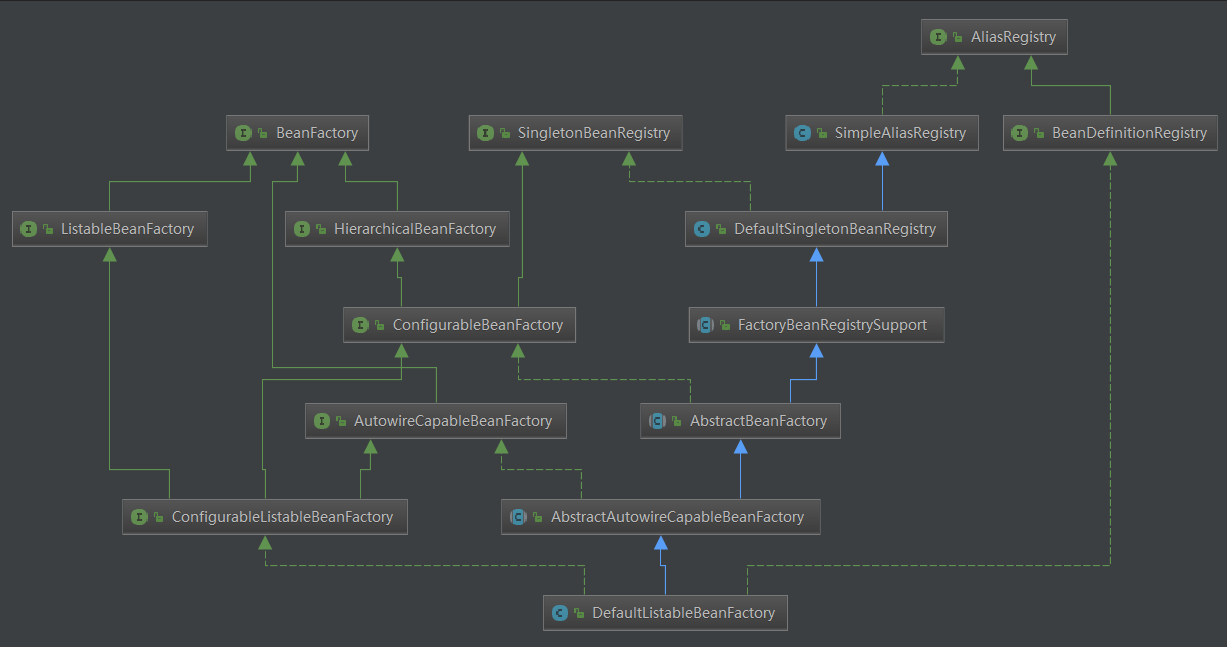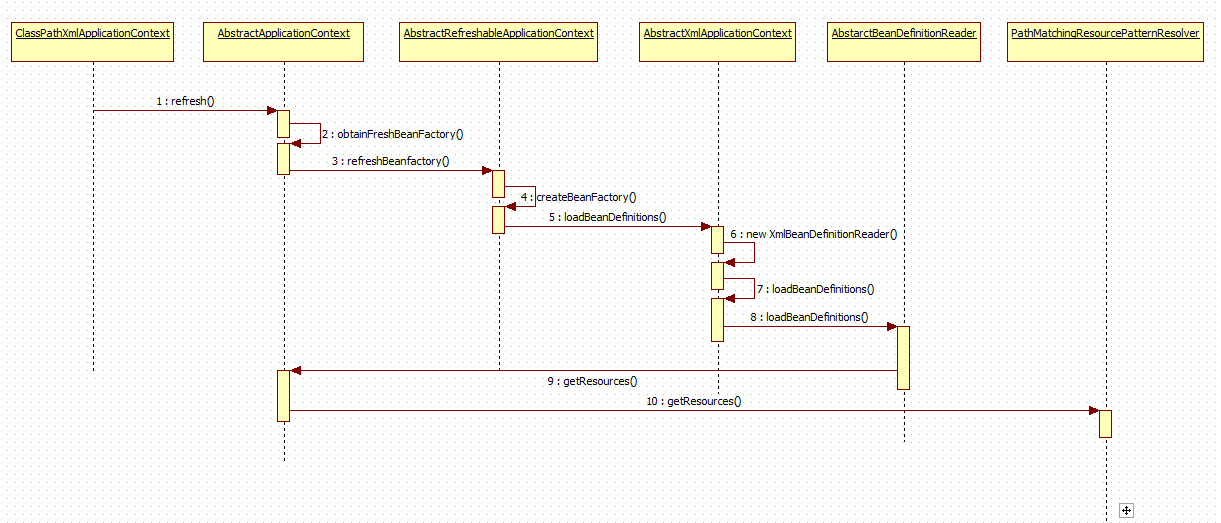Spring源码解析(二)BeanDefinition的Resource定位
IOC容器的初始化过程主要包括BeanDefinition的Resource定位、载入和注册。在实际项目中我们基本上操作的都是ApplicationContex的实现,我们比较熟悉的ClassPathXmlApplicationContext、FileSystemXmlApplicationContext、XmlWebapplicationContext等。ApplicationContext的具体继承体系如下图所示:

其实,不管是XmlWebApplicationContext还是ClasspathXmlApplicationContext 他们的区别只是Bean的资源信息来源不一样而已,最终都会解析为统一数据结构BeanDefinition。
下面我们源码的解析就从高富帅的ClassPathXmlApplicationContext开始。
ClassPathXmlApplicationContext context=new ClassPathXmlApplicationContext("classpath*:test.xml");
构造方法:
/**
* Create a new ClassPathXmlApplicationContext, loading the definitions
* from the given XML file and automatically refreshing the context.
* @param configLocation resource location
* @throws BeansException if context creation failed
*/
public ClassPathXmlApplicationContext(String configLocation) throws BeansException {
this(new String[] {configLocation}, true, null);
}
最终调用构造方法:
/**
* Create a new ClassPathXmlApplicationContext with the given parent,
* loading the definitions from the given XML files.
* @param configLocations array of resource locations
* @param refresh whether to automatically refresh the context,
* loading all bean definitions and creating all singletons.
* Alternatively, call refresh manually after further configuring the context.
* @param parent the parent context
* @throws BeansException if context creation failed
* @see #refresh()
*/
public ClassPathXmlApplicationContext(String[] configLocations, boolean refresh, ApplicationContext parent)
throws BeansException { super(parent);
setConfigLocations(configLocations);
if (refresh) {
refresh();
}
}
1.设置父级上下文,最终是给AbstractApplicationContext的parent属性赋值,AbstractApplicationContext是ApplicationContext最顶层的实现类。
2.设置XML文件的位置,调用了AbstractRefreshableConfigApplicationContext的setConfigLocations方法
/**
* Set the config locations for this application context.
* <p>If not set, the implementation may use a default as appropriate.
*/
public void setConfigLocations(String[] locations) {
if (locations != null) {
Assert.noNullElements(locations, "Config locations must not be null");
this.configLocations = new String[locations.length];
for (int i = 0; i < locations.length; i++) {
this.configLocations[i] = resolvePath(locations[i]).trim();
}
}
else {
this.configLocations = null;
}
}
3.刷新容器,调用了AbstractApplicationContext的refresh方法,这是一个模板方法,具体的操作都是有子类去实现的。
public void refresh() throws BeansException, IllegalStateException {
synchronized (this.startupShutdownMonitor) {
// Prepare this context for refreshing.
//刷新容器前的准备工作
prepareRefresh();
// Tell the subclass to refresh the internal bean factory.
//由子类实现容器的刷新(重启)
ConfigurableListableBeanFactory beanFactory = obtainFreshBeanFactory();
// Prepare the bean factory for use in this context.
/*容器使用前的准备工作*/
prepareBeanFactory(beanFactory);
try {
// Allows post-processing of the bean factory in context subclasses.
//甚至beanFacotry的后置处理
postProcessBeanFactory(beanFactory);
// Invoke factory processors registered as beans in the context.
//调用BeanFactory的后置处理器,这些后置处理是在Bean定义中想容器注册的
invokeBeanFactoryPostProcessors(beanFactory);
// Register bean processors that intercept bean creation.
//注册Bean的后置处理器,在Bean的创建过程中调用
registerBeanPostProcessors(beanFactory);
// Initialize message source for this context.
//对上下文中的消息源进行初始化
initMessageSource();
// Initialize event multicaster for this context.
//初始化上下文的事件
initApplicationEventMulticaster();
// Initialize other special beans in specific context subclasses.
//初始化其他特殊的Bean
onRefresh();
// Check for listener beans and register them.
//向容器注册监听Bean
registerListeners();
// Instantiate all remaining (non-lazy-init) singletons.
//实例化所有非延迟加载的Bean
finishBeanFactoryInitialization(beanFactory);
// Last step: publish corresponding event.
//发布容器事件,结束refresh过程
finishRefresh();
}
catch (BeansException ex) {
logger.warn("Exception encountered during context initialization - cancelling refresh attempt", ex);
// Destroy already created singletons to avoid dangling resources.
destroyBeans();
// Reset 'active' flag.
cancelRefresh(ex);
// Propagate exception to caller.
throw ex;
}
}
}
prepareRefresh():主要是设置启动时间、状态等等;
我们着重看一下刷新容器的obtainFreshBeanFactory()方法:
/**
* Tell the subclass to refresh the internal bean factory.
* @return the fresh BeanFactory instance
* @see #refreshBeanFactory()
* @see #getBeanFactory()
*/
protected ConfigurableListableBeanFactory obtainFreshBeanFactory() {
//销毁已有容器,重新创建容器并加载Bean
refreshBeanFactory();
ConfigurableListableBeanFactory beanFactory = getBeanFactory();
if (logger.isDebugEnabled()) {
logger.debug("Bean factory for " + getDisplayName() + ": " + beanFactory);
}
return beanFactory;
}
AbstractApplicationConetxt的refreshBeanFactory()方法是一个抽象方法,是由它的子类AbstractRefreshableApplicationContext实现的,从类的命名上可以看出这个类主要就是进行容器Refresh用的。
/**
* This implementation performs an actual refresh of this context's underlying
* bean factory, shutting down the previous bean factory (if any) and
* initializing a fresh bean factory for the next phase of the context's lifecycle.
*/
@Override
protected final void refreshBeanFactory() throws BeansException {
//如果容器已经存在则销毁容器中的bean并关闭容器
if (hasBeanFactory()) {
destroyBeans();
closeBeanFactory();
}
try {
//创建beanFacotry
DefaultListableBeanFactory beanFactory = createBeanFactory();
beanFactory.setSerializationId(getId());
customizeBeanFactory(beanFactory);
//根据bean定义的方式(XML、注解等)不同,由子类选择相应的BeanDefinitionReader去解析
loadBeanDefinitions(beanFactory);
synchronized (this.beanFactoryMonitor) {
this.beanFactory = beanFactory;
}
}
catch (IOException ex) {
throw new ApplicationContextException("I/O error parsing bean definition source for " + getDisplayName(), ex);
}
}
第一步: 这个方法会判断如果已存在容器,则先销毁所有的Bean并且关闭容器,这也是为了保证容器的唯一性。
第二步:createBeanFactory()创建了一个DefaultListableBeanFactory,这个类是BeanFacotry最高级的实现,有了它就有个容器最基本的功能了。
/**
* Create an internal bean factory for this context.
* Called for each {@link #refresh()} attempt.
* <p>The default implementation creates a
* {@link org.springframework.beans.factory.support.DefaultListableBeanFactory}
* with the {@linkplain #getInternalParentBeanFactory() internal bean factory} of this
* context's parent as parent bean factory. Can be overridden in subclasses,
* for example to customize DefaultListableBeanFactory's settings.
* @return the bean factory for this context
* @see org.springframework.beans.factory.support.DefaultListableBeanFactory#setAllowBeanDefinitionOverriding
* @see org.springframework.beans.factory.support.DefaultListableBeanFactory#setAllowEagerClassLoading
* @see org.springframework.beans.factory.support.DefaultListableBeanFactory#setAllowCircularReferences
* @see org.springframework.beans.factory.support.DefaultListableBeanFactory#setAllowRawInjectionDespiteWrapping
*/
protected DefaultListableBeanFactory createBeanFactory() {
//新建一个DefaultListableBeanFactory
return new DefaultListableBeanFactory(getInternalParentBeanFactory());
}
DefaultListableBeanFactory的继承关系:

我们看到DefaultListableBeanFactory实现了BeanDefinitionRegistry接口,也就是说最终BeanDefinition的注册工作是由它和它的子类来完成的。
第三步:loadBeanDefinitions(beanFactory),这个方法也是一个抽象方法。因为Bean定义方式不同(XML、注解等),会有多个子类分别去实现具体的解析。

此处,调用的是AbstractXmlApplicationContext的实现:
/**
* Loads the bean definitions via an XmlBeanDefinitionReader.
* @see org.springframework.beans.factory.xml.XmlBeanDefinitionReader
* @see #initBeanDefinitionReader
* @see #loadBeanDefinitions
*/
@Override
protected void loadBeanDefinitions(DefaultListableBeanFactory beanFactory) throws BeansException, IOException {
// Create a new XmlBeanDefinitionReader for the given BeanFactory.
XmlBeanDefinitionReader beanDefinitionReader = new XmlBeanDefinitionReader(beanFactory); // Configure the bean definition reader with this context's
// resource loading environment.
beanDefinitionReader.setEnvironment(this.getEnvironment());
//ApplicationContext继承了ResourceLoader接口,所以this是可以直接使用的
beanDefinitionReader.setResourceLoader(this);
beanDefinitionReader.setEntityResolver(new ResourceEntityResolver(this)); // Allow a subclass to provide custom initialization of the reader,
// then proceed with actually loading the bean definitions.
initBeanDefinitionReader(beanDefinitionReader);
//委派模式,具体事情委派给beanDefinitionReader去做
loadBeanDefinitions(beanDefinitionReader);
}
进入loadBeanDefinitions(XmlBeanDefinitionReader reader):
/**
* Load the bean definitions with the given XmlBeanDefinitionReader.
* <p>The lifecycle of the bean factory is handled by the {@link #refreshBeanFactory}
* method; hence this method is just supposed to load and/or register bean definitions.
* @param reader the XmlBeanDefinitionReader to use
* @throws BeansException in case of bean registration errors
* @throws IOException if the required XML document isn't found
* @see #refreshBeanFactory
* @see #getConfigLocations
* @see #getResources
* @see #getResourcePatternResolver
*/
protected void loadBeanDefinitions(XmlBeanDefinitionReader reader) throws BeansException, IOException {
Resource[] configResources = getConfigResources();
if (configResources != null) {
reader.loadBeanDefinitions(configResources);
}
String[] configLocations = getConfigLocations();
if (configLocations != null) {
reader.loadBeanDefinitions(configLocations);
}
}
该方法调用了XmlBeanDefinitionReader父类AbstractBeanDefinitionReader的loadBeanDefinitions方法:
public int loadBeanDefinitions(String... locations) throws BeanDefinitionStoreException {
Assert.notNull(locations, "Location array must not be null");
int counter = 0;
for (String location : locations) {
counter += loadBeanDefinitions(location);
}
return counter;
}
l循环加载location并返回加载个数,最终调用了本类的loadBeanDefinitions(String location, Set<Resource> actualResources)方法,actualResources为null:
/**
* Load bean definitions from the specified resource location.
* <p>The location can also be a location pattern, provided that the
* ResourceLoader of this bean definition reader is a ResourcePatternResolver.
* @param location the resource location, to be loaded with the ResourceLoader
* (or ResourcePatternResolver) of this bean definition reader
* @param actualResources a Set to be filled with the actual Resource objects
* that have been resolved during the loading process. May be {@code null}
* to indicate that the caller is not interested in those Resource objects.
* @return the number of bean definitions found
* @throws BeanDefinitionStoreException in case of loading or parsing errors
* @see #getResourceLoader()
* @see #loadBeanDefinitions(org.springframework.core.io.Resource)
* @see #loadBeanDefinitions(org.springframework.core.io.Resource[])
*/
public int loadBeanDefinitions(String location, Set<Resource> actualResources) throws BeanDefinitionStoreException {
ResourceLoader resourceLoader = getResourceLoader();
if (resourceLoader == null) {
throw new BeanDefinitionStoreException(
"Cannot import bean definitions from location [" + location + "]: no ResourceLoader available");
}
//resourceLoader是ClasspathXmlApplicationContext,ApplicationContext接口本身继承了ResourcePatternResolver接口
if (resourceLoader instanceof ResourcePatternResolver) {
// Resource pattern matching available.
try {
//location转为Resource完成定位工作
Resource[] resources = ((ResourcePatternResolver) resourceLoader).getResources(location);
int loadCount = loadBeanDefinitions(resources);
if (actualResources != null) {
for (Resource resource : resources) {
actualResources.add(resource);
}
}
if (logger.isDebugEnabled()) {
logger.debug("Loaded " + loadCount + " bean definitions from location pattern [" + location + "]");
}
return loadCount;
}
catch (IOException ex) {
throw new BeanDefinitionStoreException(
"Could not resolve bean definition resource pattern [" + location + "]", ex);
}
}
else {
// Can only load single resources by absolute URL.
Resource resource = resourceLoader.getResource(location);
int loadCount = loadBeanDefinitions(resource);
if (actualResources != null) {
actualResources.add(resource);
}
if (logger.isDebugEnabled()) {
logger.debug("Loaded " + loadCount + " bean definitions from location [" + location + "]");
}
return loadCount;
}
}
Resource[] resources = ((ResourcePatternResolver) resourceLoader).getResources(location)将location转成了Resource[],这一步完成了资源的定位工作。
它调用了PathMatchingResourcePatternResolver的getResources方法:
public Resource[] getResources(String locationPattern) throws IOException {
Assert.notNull(locationPattern, "Location pattern must not be null");
//是否以classpath*:开头
if (locationPattern.startsWith(CLASSPATH_ALL_URL_PREFIX)) {
// a class path resource (multiple resources for same name possible)
//是否为Ant-style路径
//? 匹配任何单字符
//* 匹配0或者任意数量的字符
//** 匹配0或者更多的目录
if (getPathMatcher().isPattern(locationPattern.substring(CLASSPATH_ALL_URL_PREFIX.length()))) {
// a class path resource pattern
return findPathMatchingResources(locationPattern);
}
else {
// all class path resources with the given name
return findAllClassPathResources(locationPattern.substring(CLASSPATH_ALL_URL_PREFIX.length()));
}
}
else {
// Only look for a pattern after a prefix here
// (to not get fooled by a pattern symbol in a strange prefix).
int prefixEnd = locationPattern.indexOf(":") + 1;
if (getPathMatcher().isPattern(locationPattern.substring(prefixEnd))) {
// a file pattern
return findPathMatchingResources(locationPattern);
}
else {
// a single resource with the given name
return new Resource[] {getResourceLoader().getResource(locationPattern)};
}
}
}
根据location写法,解析方式也不同:
1、前缀为classpath*
1)文件路径路径中包含*和?
调用findPathMatchingResources方法
2)文件路径中不含*和?
调用findAllClassPathResources方法
2.、前缀为classpath
1)文件路径路径中包含*和?
调用findPathMatchingResources方法
2)文件路径中不含*和?
调用DefaultResourceLoader的getResource方法new一个ClasspathResource并返回,如果资源文件根本就不存在,此处也不会校验。
findPathMatchingResources和findAllClassPathResources具体都干了什么呢?
先看一下findAllClassPathResources:
/**
* Find all class location resources with the given location via the ClassLoader.
* @param location the absolute path within the classpath
* @return the result as Resource array
* @throws IOException in case of I/O errors
* @see java.lang.ClassLoader#getResources
* @see #convertClassLoaderURL
*/
protected Resource[] findAllClassPathResources(String location) throws IOException {
String path = location;
if (path.startsWith("/")) {
path = path.substring(1);
}
ClassLoader cl = getClassLoader();
Enumeration<URL> resourceUrls = (cl != null ? cl.getResources(path) : ClassLoader.getSystemResources(path));
Set<Resource> result = new LinkedHashSet<Resource>(16);
while (resourceUrls.hasMoreElements()) {
URL url = resourceUrls.nextElement();
result.add(convertClassLoaderURL(url));
}
return result.toArray(new Resource[result.size()]);
}
protected Resource convertClassLoaderURL(URL url) {
return new UrlResource(url);
}
这个方法很简单,根据具体的location通过classLoader的getResources方法返回RUL集合,根据URL创建UrlResource并返回UrlResource的集合。
再来看一下findPathMatchingResources方法:
/**
* Find all resources that match the given location pattern via the
* Ant-style PathMatcher. Supports resources in jar files and zip files
* and in the file system.
* @param locationPattern the location pattern to match
* @return the result as Resource array
* @throws IOException in case of I/O errors
* @see #doFindPathMatchingJarResources
* @see #doFindPathMatchingFileResources
* @see org.springframework.util.PathMatcher
*/
protected Resource[] findPathMatchingResources(String locationPattern) throws IOException {
String rootDirPath = determineRootDir(locationPattern);
String subPattern = locationPattern.substring(rootDirPath.length());
Resource[] rootDirResources = getResources(rootDirPath);
Set<Resource> result = new LinkedHashSet<Resource>(16);
for (Resource rootDirResource : rootDirResources) {
rootDirResource = resolveRootDirResource(rootDirResource);
if (rootDirResource.getURL().getProtocol().startsWith(ResourceUtils.URL_PROTOCOL_VFS)) {
result.addAll(VfsResourceMatchingDelegate.findMatchingResources(rootDirResource, subPattern, getPathMatcher()));
}
else if (isJarResource(rootDirResource)) {
result.addAll(doFindPathMatchingJarResources(rootDirResource, subPattern));
}
else {
result.addAll(doFindPathMatchingFileResources(rootDirResource, subPattern));
}
}
if (logger.isDebugEnabled()) {
logger.debug("Resolved location pattern [" + locationPattern + "] to resources " + result);
}
return result.toArray(new Resource[result.size()]);
}
1.String rootDirPath = determineRootDir(locationPattern),获取location前缀classpath*/classpath
2.Resource[] rootDirResources = getResources(rootDirPath),调用的上面讲到的getResources方法,返回classpath根路径的Resource[],如果是classpath会返回一个Resource,
如果是classpath*会放回所有的classpath路径。
3.遍历根路径Resource[],doFindPathMatchingFileResources方法就是获取给定路径下的所有文件,根据指定的文件名test*.xml去模糊匹配,返回的是FileSystemResource。所以location为classpath:test*.xml可能会找不到文件。

Spring源码解析(二)BeanDefinition的Resource定位的更多相关文章
- Spring源码解析二:IOC容器初始化过程详解
IOC容器初始化分为三个步骤,分别是: 1.Resource定位,即BeanDefinition的资源定位. 2.BeanDefinition的载入 3.向IOC容器注册BeanDefinition ...
- spring源码解析(二) 结合源码聊聊FactoryBean
一.什么是FactoryBean FactoryBean是由spring提供的用来让用户可以自定bean创建的接口:实现该接口可以让你的bean不用经过spring复杂的bean创建过程,但同时也能做 ...
- Spring源码解析之ConfigurationClassPostProcessor(二)
上一个章节,笔者向大家介绍了spring是如何来过滤配置类的,下面我们来看看在过滤出配置类后,spring是如何来解析配置类的.首先过滤出来的配置类会存放在configCandidates列表, 在代 ...
- 剑指Spring源码(二)
这是春节后的第一篇博客,我在构思这篇博客的时候,一度想放弃,想想要不要换个东西写,因为毕竟个人水平有限,Spring源码实在博大精深,不是我这个菜的抠脚的菜鸡可以驾驭的,怕误人子弟,还有就是源码分析类 ...
- spring 源码解析
1. [文件] spring源码.txt ~ 15B 下载(167) ? 1 springн┤┬вио╬Ш: 2. [文件] spring源码分析之AOP.txt ~ 15KB 下载( ...
- Spring源码解析-ioc容器的设计
Spring源码解析-ioc容器的设计 1 IoC容器系列的设计:BeanFactory和ApplicatioContext 在Spring容器中,主要分为两个主要的容器系列,一个是实现BeanFac ...
- Spring源码解析系列汇总
相信我,你会收藏这篇文章的 本篇文章是这段时间撸出来的Spring源码解析系列文章的汇总,总共包含以下专题.喜欢的同学可以收藏起来以备不时之需 SpringIOC源码解析(上) 本篇文章搭建了IOC源 ...
- Spring源码解析之BeanFactoryPostProcessor(三)
在上一章中笔者介绍了refresh()的<1>处是如何获取beanFactory对象,下面我们要来学习refresh()方法的<2>处是如何调用invokeBeanFactor ...
- Spring源码分析——资源访问利器Resource之实现类分析
今天来分析Spring的资源接口Resource的各个实现类.关于它的接口和抽象类,参见上一篇博文——Spring源码分析——资源访问利器Resource之接口和抽象类分析 一.文件系统资源 File ...
- Spring源码解析——循环依赖的解决方案
一.前言 承接<Spring源码解析--创建bean>.<Spring源码解析--创建bean的实例>,我们今天接着聊聊,循环依赖的解决方案,即创建bean的ObjectFac ...
随机推荐
- Unity UI大小动态设置(Resize Unity UI RectTransform)
我们在开发过程中发现,要调整Unity UI元素的大小,RectTransform提供了sizeDelta属性可以用来动态修改RectTransform的大小,但同时我们也google到另外一个修改R ...
- 使用mshflxgd.ocx控件
msflxgrd.ocx - Microsoft FlexGrid Control 原先使用的是msflxgrd控件,但是使用过程中发现,Cell中的中文字符串在英文系统下显示“??”,查找资料发现该 ...
- VS2008 Output窗口自动滚动
Output窗口默认是自动滚动的,活动光标始终处于最后一行. 但是有时候因为某些操作可能导致Output窗口的自动滚动停止. 如何恢复自动滚动呢? 使用快捷键操作即可:Ctrl + End
- java jdk-awt.font在centos上中文乱码的问题, 安装中文字体
有需求生成一个二维码,并且有一段文本说明,但是使用awt.font来生成中文时,一直存在乱码的问题.网上的解决办法有几种,但是在centos上亲测有用的就是如下的方法. Java代码如下:new ja ...
- python2.0_s12_day10_rabbitMQ使用介绍
RabbitMQ RabbitMQ是一个在AMQP基础上完整的,可复用的企业消息系统.他遵循Mozilla Public License开源协议. MQ全称为Message Queue, 消息队列(M ...
- day7_直播_网络编程篇(元昊老师著)
网络编程篇计算机网络: 多台独立的计算机用网络通信设备连接起来的网络.实现资源共享和数据传递. 比如,我们之前的学过的知识可以将D盘的一个文件传到C盘,但如果你想从你的电脑传一个文件到我的电脑上目前是 ...
- laravel 控制器构造方法注入request对象
IndexController: <?php namespace App\Http\Controllers; use Illuminate\Http\Request; use App\Http\ ...
- 第七篇:Logistic回归分类算法原理分析与代码实现
前言 本文将介绍机器学习分类算法中的Logistic回归分类算法并给出伪代码,Python代码实现. (说明:从本文开始,将接触到最优化算法相关的学习.旨在将这些最优化的算法用于训练出一个非线性的函数 ...
- C语言各种存储模式的区别?最常用的存储模式有哪些?
DOS用一种段地址结构来编址计算机的内存,每一个物理内存位置都有一个可通过段地址一偏移量的方式来访问的相关地址.为了支持这种段地址结构,大多数C编译程序都允许你用以下6种存储模式来创建程序: ---- ...
- 详解Integer.toString(int i)方法和String.valueOf(int i)方法
通过查看String类的源码: public static String valueOf(int i) { return Integer.toString(i); } 我们可以看到,String.va ...
